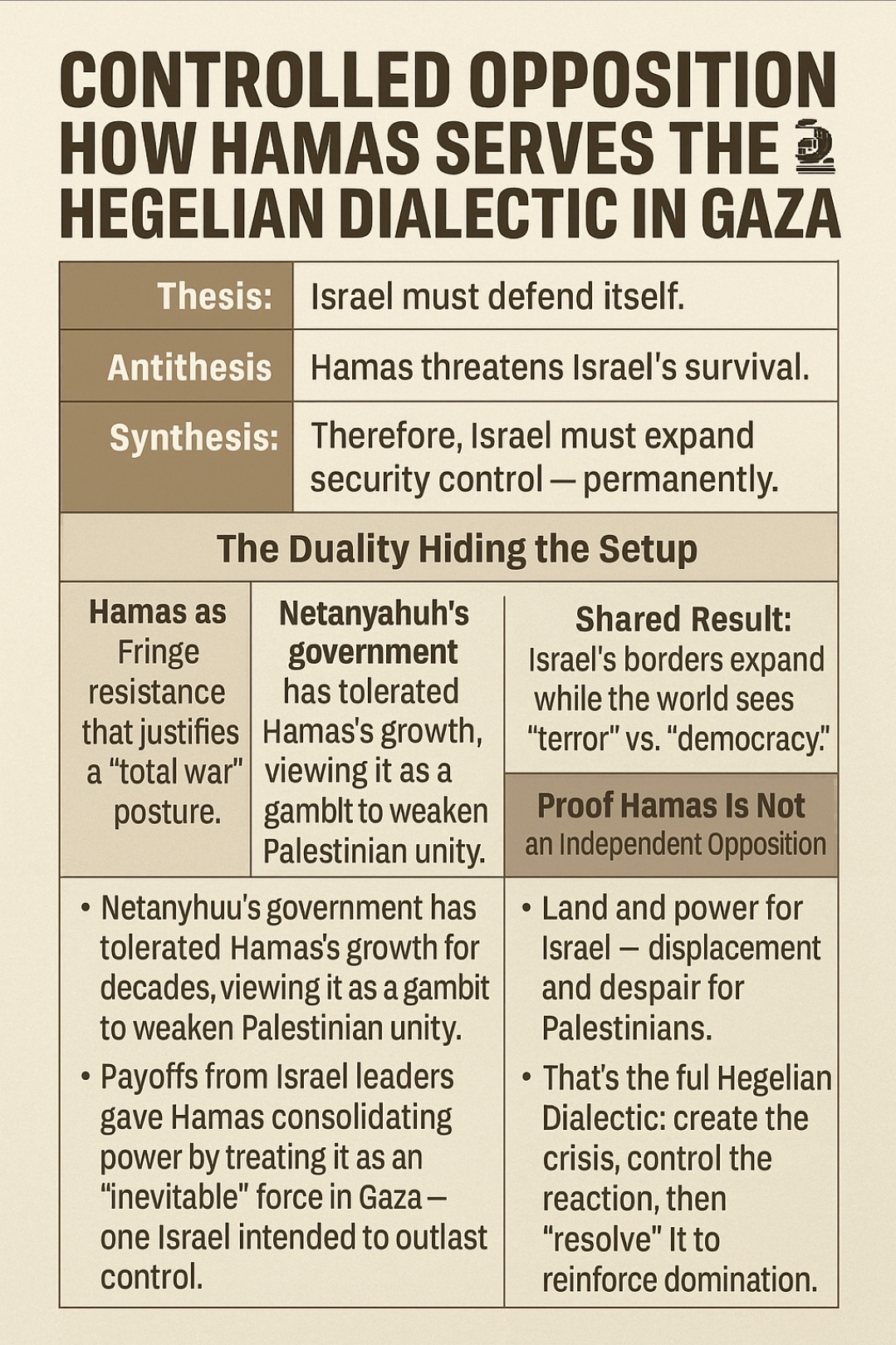This article argues that Hamas often functions less as an independent representative of Palestinians and more as a foil that stabilizes Israeli hard-line policy and outside political agendas. In a classic Hegelian dialectic—thesis, antithesis, synthesis—Hamas provides the spectacle and violence (antithesis) that make a preselected outcome (expanded control, permanent “security” structures, and land consolidation—the synthesis) appear inevitable and justified. The point isn’t to excuse Hamas’s crimes or deny Israeli security concerns; it’s to show how managed conflict can become the engine of policy, not its failure.
1) The Dialectic Template
- Thesis: “Israel must defend itself.”
- Antithesis: “Hamas threatens Israel’s survival.”
- Synthesis: “Therefore, Israel must deepen security control, indefinitely.”
When the public accepts that only two options exist—Hamas rule or Israeli force—everything between those poles disappears (ceasefires, third-party administration, broader Palestinian representation, international guarantees). The dialectic narrows imagination so the “inevitable” outcome looks like prudence, not design.
2) How Controlled Opposition Works in Practice
A) Cultivating the Foil
Critics have long noted policies that de-prioritized non-militant Palestinian leadership while tolerating or indirectly enabling Hamas’s primacy in Gaza (e.g., easing rival-weakening measures, allowing outside cash infusions, fragmenting West Bank/Gaza governance). Whether by intent or by short-term expediency, the effect is the same: keep a radical antagonist in the frame to justify maximal security policy.
B) Provocation–Retaliation–Expansion
- Provocation: Rocket fire, raids, atrocities, hostage-taking.
- Retaliation: Air campaigns, sieges, ground incursions.
- Expansion: New buffer zones, settlement growth, tightened movement, legal/administrative consolidation.
Each cycle ratchets the status quo in one direction, even when operations are sold as temporary.
C) Narrative Capture
Media and political rhetoric reduce millions of civilians to “Hamas,” erasing plural Palestinian voices. Once the population is linguistically merged with the militia, collective punishment masquerades as counter-terrorism, and objections are smeared as “support for Hamas.”
D) Domestic Utility (Israel & Abroad)
- In Israel, a permanent “state of exception” rallies voters, sidelines critics, and binds security institutions to political leadership.
- Internationally, allied politicians gain moral credit: “We backed peace; militants refused.” The outcome—escalation—was always compatible with their interests.
3) Rhetorical Engineering: How “Peace” Becomes a Weapon
- False dilemma: “Accept our comprehensive plan or we ‘finish the job.’”
- Moral licensing: Float an impossible peace framework to bank righteousness in advance.
- Loaded euphemisms: “Finish the job,” “humanitarian corridors,” “safe zones” that later become pretexts for displacement.
- Strategic ambiguity: Vague terms (“demilitarization,” “security guarantees”) enable unilateral interpretations that manufacture noncompliance later.
These tactics convert planned outcomes into seemingly forced necessities.
4) Why Hamas Is the “Perfect” Adversary for Hard-Line Policy
- Optics: Militancy and theocratic rhetoric alienate global moderates; images of rockets and massacres secure sympathy for crackdowns.
- Fragmentation: Hamas’s rule in Gaza fractures Palestinian politics, weakening diplomatic counterparts who might credibly negotiate.
- Predictability: Periodic escalations keep security budgets and exceptional powers politically untouchable.
In short: Hamas concentrates legitimacy for maximal responses while diluting credible alternatives.
5) Civilian Reality: The Disappearing Middle
The dialectic crushes the space for:
- Broader Palestinian representation beyond Hamas,
- International trusteeship or Arab-led transitional administrations,
- Enforceable rights frameworks that separate civilians from combatants,
- Long-horizon political settlements tied to measurable benchmarks.
Civilians become statistics in a policy machine that requires their perpetual precarity to run.
6) How to Test the “Controlled Opposition” Hypothesis
A responsible claim invites falsification. Here are measurable indicators journalists, researchers, and watchdogs can track:
- Policy Asymmetry: Compare resources/political oxygen invested in weakening moderate Palestinian governance vs. containing Hamas.
- Funding & Facilitation: Audit flows (e.g., third-party cash, work permits, border gate policies) that have historically stabilized Hamas’s rule while undermining rivals.
- Crisis Payoffs: After each escalation, map net territorial/security gains and permanent administrative changes.
- Law & Oversight: Track whether wartime exceptions become peacetime norms (detention, surveillance, movement restrictions).
- Media Framing: Quantify coverage that linguistically merges “Gaza civilians” with “Hamas,” enabling collective punishment narratives.
- Suppression of Alternatives: Document vetoes or sabotage of proposals for international administration or inclusive Palestinian governance.
- Domestic Politics: Correlate escalation cycles with leadership approval, coalition stability, and electoral timing.
If these indicators consistently point one way—conflict yields durable gains for one side while entrenching the antagonist’s role—the “controlled opposition” model gains explanatory power.
7) What a Non-Dialectical Peace Track Would Look Like
- Decouple civilians from militants in law and logistics: protected corridors, independently verified registries, and sanctions against collective punishment.
- Interim international administration in Gaza with Arab/EU/UN components, time-bounded and benchmarked.
- Inclusive Palestinian representation (municipal, professional, religious, civil) beyond factional militias.
- Security guarantees with reciprocity: third-party monitoring, verifiable arms controls, and clear snap-back provisions for violations—on both sides.
- Freeze-to-final pathway: settlement freeze, movement normalization, phased elections, and staged recognition tied to rights outcomes.
- Independent accountability: standing investigative mechanisms for violations, binding on all parties, insulated from political vetoes.
This path widens the field beyond “Hamas or occupation,” breaking the dialectic’s spell.
8) Why This Matters Beyond Gaza
Dialectical conflict management appears wherever leaders need fear to govern: keep a radical foil alive, rotate shocks, and harvest “inevitable” hard-power solutions. Seeing the pattern inoculates citizens against manufactured binaries that trade liberty and human dignity for performative security.
Conclusion
Condemning Hamas’s crimes and defending Israeli lives are not in tension with rejecting a system that needs the conflict to persist. If Hamas operates—by design or by consequence—as the indispensable enemy that secures perpetual exception, then the real enemy is the architecture of managed war. Breaking the Hegelian trap requires expanding the option set, protecting civilians as civilians, empowering plural Palestinian representation, and ending the political dividends of escalation.
Peace is not the absence of an adversary.
Peace is the presence of alternatives—and the courage to choose them.






